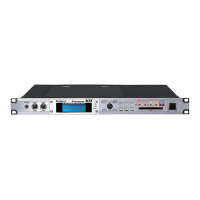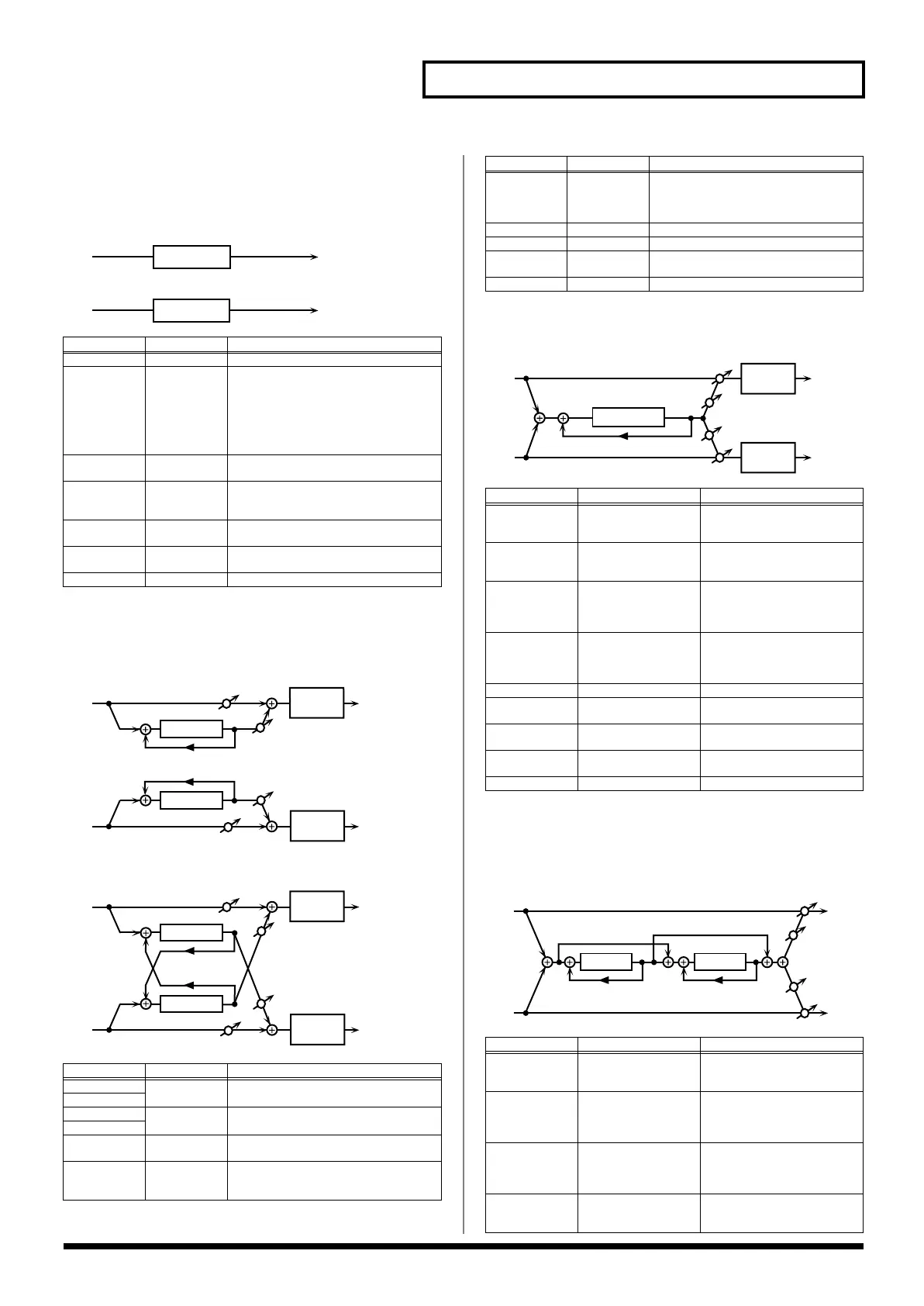205
Effects List
42: GATE
Cuts the reverb’s delay according to the volume of the sound sent
into the effect. Use this when you want to create an artificial-
sounding decrease in the reverb’s decay.
fig.MFX-42
43: DELAY
This is a stereo delay.
When Feedback Mode is NORMAL:
fig.MFX-43a
When Feedback Mode is CROSS:
fig.MFX-43b
44: LONG DELAY
A delay that provides a long delay time.
fig.MFX-44
45: SERIAL DELAY
This delay connects two delay units in series. Feedback can be
applied independently to each delay unit, allowing you to produce
complex delay sounds.
fig.MFX-45
Parameter
Value Description
Threshold # 0–127
Volume level at which the gate begins to close
Mode GATE,
DUCK
Type of gate
GATE:
The gate will close when the vol-
ume of the original sound decreases,
cutting the original sound.
DUCK (Ducking):
The gate will close
when the volume of the original sound
increases, cutting the original sound.
Attack 0–127 Adjusts the time it takes for the gate to fully
open after being triggered.
Hold 0–127 Adjusts the time it takes for the gate to start
closing after the source sound falls beneath
the Threshold.
Release 0–127 Adjusts the time it takes the gate to fully
close after the hold time.
Balance # D100:0W–
D0:100W
Volume balance between the direct sound
(D) and the effect sound (W)
Level 0–127 Output level
Parameter
Value Description
Delay Left
0–1300 ms,
note
Adjusts the time until the delay sound is
heard.
Delay Right
Phase Left NORMAL,
INVERSE
Phase of the delay sound
Phase Right
Feedback
Mode
NORMAL,
CROSS
Selects the way in which delay sound is fed
back into the effect. (See the figures above.)
Feedback # -98– +98 % Adjusts the amount of the delay sound
that’s fed back into the effect. Negative
(-) settings invert the phase.
L in
R in
L out
R out
Gate
Gate
R in
R out
L in
L out
Feedback
Feedback
Balance W
Balance D
Balance W
Balance D
2-Band
EQ
2-Band
EQ
Delay
Delay
R in
R out
L in
L out
Feedback
Feedback
Balance W
Balance D
Balance W
Balance D
2-Band
EQ
2-Band
EQ
Delay
Delay
HF Damp
200–8000 Hz,
BYPASS
Adjusts the frequency above which sound
fed back to the effect is filtered out. If you
don’t want to filter out any high frequencies,
set this parameter to BYPASS.
Low Gain -15– +15 dB Gain of the low frequency range
High Gain -15– +15 dB Gain of the high frequency range
Balance # D100:0W–
D0:100W
Volume balance between the direct sound
(D) and the delay sound (W)
Level 0–127 Output level
Parameter
Range Explanation
Delay Time
0–2600 ms, note Delay time from when the origi-
nal sound is heard to when the
delay sound is heard
Phase NORMAL, INVERSE Phase of the delay (NORMAL:
non-inverted, INVERT: invert-
ed)
Feedback # -98– +98% Proportion of the delay sound
that is to be returned to the in-
put (negative values invert the
phase)
HF Damp 200–8000 Hz,
BYPASS
Frequency at which the high-
frequency content of the de-
layed sound will be cut (BY-
PASS: no cut)
Pan # L64–63R Panning of the delay sound
Low Gain -15– +15 dB Amount of boost/cut for the
high-frequency range
High Gain -15– +15 dB Amount of boost/cut for the
high-frequency range
Balance # D100:0W–D0:100W Volume balance of the original
sound (D) and delay sound (W)
Level 0–127 Output volume
Parameter
Range Explanation
Delay1 Time
0–1300 ms, note Delay time from when sound is
input to delay 1 until the delay
sound is heard
Delay1
Feedback #
-98– +98% Proportion of the delay sound
that is to be returned to the in-
put of delay 1 (negative values
invert the phase)
Delay1 HF Damp 200–8000 Hz,
BYPASS
Frequency at which the high-
frequency content of the de-
layed sound of delay 1 will be
cut (BYPASS: no cut)
Delay2 Time 0–1300 ms, note Delay time from when sound is
input to delay 2 until the delay
sound is heard
Parameter
Value Description
L in
R in
L out
R out
2-Band
EQ
Pan R
Pan L
2-Band
EQ
Feedback
Long Delay
R in
R out
L in
L out
Feedback 1
Pan L
Pan R
Delay 1
Feedback 2
Delay 2
Fantom-XR_r_e.book 205 ページ 2006年4月4日 火曜日 午前10時14分

